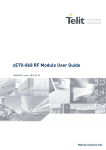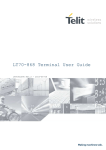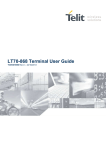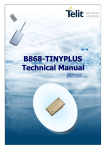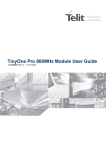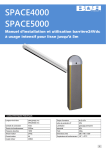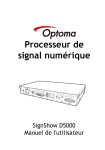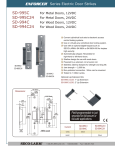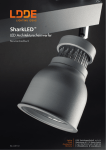Download xE50-433/868 RF Module User Guide
Transcript
SPECIFICATIONS SUBJECT TO CHANGE WITHOUT NOTICE Notice While reasonable efforts have been made to assure the accuracy of this document, Telit assumes no liability resulting from any inaccuracies or omissions in this document, or from use of the information obtained herein. The information in this document has been carefully checked and is believed to be entirely reliable. However, no responsibility is assumed for inaccuracies or omissions. Telit reserves the right to make changes to any products described herein and reserves the right to revise this document and to make changes from time to time in content hereof with no obligation to notify any person of revisions or changes. Telit does not assume any liability arising out of the application or use of any product, software, or circuit described herein; neither does it convey license under its patent rights or the rights of others. It is possible that this publication may contain references to, or information about Telit products (machines and programs), programming, or services that are not announced in your country. Such references or information must not be construed to mean that Telit intends to announce such Telit products, programming, or services in your country. Copyrights This instruction manual and the Telit products described in this instruction manual may be, include or describe copyrighted Telit material, such as computer programs stored in semiconductor memories or other media. Laws in the Italy and other countries preserve for Telit and its licensors certain exclusive rights for copyrighted material, including the exclusive right to copy, reproduce in any form, distribute and make derivative works of the copyrighted material. Accordingly, any copyrighted material of Telit and its licensors contained herein or in the Telit products described in this instruction manual may not be copied, reproduced, distributed, merged or modified in any manner without the express written permission of Telit. Furthermore, the purchase of Telit products shall not be deemed to grant either directly or by implication, estoppel, or otherwise, any license under the copyrights, patents or patent applications of Telit, as arises by operation of law in the sale of a product. Computer Software Copyrights The Telit and 3rd Party supplied Software (SW) products described in this instruction manual may include copyrighted Telit and other 3rd Party supplied computer programs stored in semiconductor memories or other media. Laws in the Italy and other countries preserve for Telit and other 3rd Party supplied SW certain exclusive rights for copyrighted computer programs, including the exclusive right to copy or reproduce in any form the copyrighted computer program. Accordingly, any copyrighted Telit or other 3rd Party supplied SW computer programs contained in the Telit products described in this instruction manual may not be copied (reverse engineered) or reproduced in any manner without the express written permission of Telit or the 3rd Party SW supplier. Furthermore, the purchase of Telit products shall not be deemed to grant either directly or by implication, estoppel, or otherwise, any license under the copyrights, patents or patent applications of Telit or other 3rd Party supplied SW, except for the normal non-exclusive, royalty free license to use that arises by operation of law in the sale of a product. Usage and Disclosure Restrictions License Agreements The software described in this document is the property of Telit and its licensors. It is furnished by express license agreement only and may be used only in accordance with the terms of such an agreement. Copyrighted Materials Software and documentation are copyrighted materials. Making unauthorized copies is prohibited by law. No part of the software or documentation may be reproduced, transmitted, transcribed, stored in a retrieval system, or translated into any language or computer language, in any form or by any means, without prior written permission of Telit High Risk Materials Components, units, or third-party products used in the product described herein are NOT fault-tolerant and are NOT designed, manufactured, or intended for use as on-line control equipment in the following hazardous environments requiring fail-safe controls: the operation of Nuclear Facilities, Aircraft Navigation or Aircraft Communication Systems, Air Traffic Control, Life Support, or Weapons Systems (High Risk Activities"). Telit and its supplier(s) specifically disclaim any expressed or implied warranty of fitness for such High Risk Activities. Trademarks TELIT and the Stylized T Logo are registered in Trademark Office. All other product or service names are the property of their respective owners. Copyright © Telit Communications S.p.A. 2011. Scope of this document is to present the features and the application of the Telit xE50433/868 radio modules (LE50-433, LE50-868, NE50-433, NE50-868 and ME50-868). This document is intended for developers using Telit xE50-433/868 radio modules. For general contact, technical support, to report documentation errors and to order manuals, contact Telit Technical Support Center (TTSC) at: [email protected] [email protected] [email protected] [email protected] Alternatively, use: http://www.telit.com/en/products/technical-support-center/contact.php For detailed information about where you can buy the Telit modules or for recommendations on accessories and components visit: http://www.telit.com To register for product news and announcements or for product questions contact Telit Technical Support Center (TTSC). Our aim is to make this guide as helpful as possible. Keep us informed of your comments and suggestions for improvements. Telit appreciates feedback from the users of our information. This document contains the following chapters “Chapter 1: “Introduction” provides a scope for this document, target audience, contact and support information, and text conventions. “Chapter 2: “Requirements” gives an overview of the limitations imposed by Reference standards. “Chapter 3: “General Characteristics” describes in details the characteristics of the product. “Chapter 4: “Technical Description” describes in details the signals and pin-out of the product. “Chapter 5: “Process information” describes in details the delivery, storage, soldering and placement of the product. “Chapter 6: “Board Mounting Recommendations” describes in details the interface and coupling of the product. “Chapter 7: “Annexes” describes examples of propagation attenuation. “Chapter 8: “Safety Recommendations” describes recommendation for proper usage. “Chapter 9: “Glossary” shows acronyms used in the document. “Chapter 10: “Document history” describes the revision history of the document. Danger – This information MUST be followed or catastrophic equipment failure or bodily injury may occur. Caution or Warning – Alerts the user to important points about integrating the module, if these points are not followed, the module and end user equipment may fail or malfunction. Tip or Information – Provides advice and suggestions that may be useful when integrating the module. All dates are in ISO 8601 format, i.e. YYYY-MM-DD. [1] EN 300 220-2 v2.3.1, ETSI Standards for SRD , February 2010 [2] ERC Rec 70-03, ERC Recommendation for SRD, June 2010 [3] 2002/95/EC, Directive of the European Parliament and of the Council, 27 January 2003 [4] SR Tool User Guide, 1vv0300899 [5] 2006/771/EC, Harmonization of the radio spectrum for use by short-range devices [6] 2009/381/EC, Amending Decision 2006/771/EC on harmonization of the radio spectrum for use by short-range devices [7] Star Network Protocol Stack User Guide, 1vv0300873 [8] Low Power Mesh Protocol Stack User Guide, 1vv0300944 [9] Wireless M-Bus Part4+Part5 ModeR2 User Guide 1vv0300828 [10] Wireless M-Bus Part 5 Mode Q User Guide 1vv0300935 [11] EN 13757-4 : 2013 Wireless M-Bus [12] Telit_Wireless_M-bus_2013_Part4_User_Guide 1vv0300953 The LE50-433, LE50-868, NE50-868 and ME50-868 (or simply xE50-433/868) modules are multi-band radio boards, delivering up to 25 mW in the 868 MHz ISM band (unlicensed frequency band). They are delivered with preloaded protocol stacks: LE50-433 and LE50-868: “Star Network” Protocol stack NE50-433 and NE50-868: “Low Power Mesh” Protocol stack ME50-868: “Wireless M-Bus Part4+Part5 ModeR2” Protocol stack, “Wireless M-Bus Part 5 Mode Q” Protocol stack and “Wireless M-Bus Part4:2013 Protocol stack. LE50-433, LE50-868, NE50-433, NE50-868 and ME50-868 are pin-to-pin compatible with LE, NE and ME modules working at different frequencies. LE50-433, LE50-868, NE50-433, NE50-868 and ME50-868 are also pin-to-pin compatible with Telit ZE Family (ZigBee PRO stack). The “ERC recommendation 70-03” describes the 433 MHz license free band, in terms of bandwidth, maximum power, duty cycle and channel spacing. It gives the following limitations: Band 1f 1f1 1f2 ERC recommendation 70-03 Maximum Channel spacing radiated power (kHz) (mW) 433.050 – 434.790 10 No channel spacing specified 1 433.050 – 434.790 No channel spacing specified (-13dBm/10kHz) 434.040 – 434.790 10 25 Frequency band (MHz) Duty cycle (%) 10 100 100 These bands are free to use but the module and the user must respect some limitations. Most of these restrictions are integrated in the conception of the module, except the duty cycle. For example, the 1e band is limited to a 10% duty cycle. This means that each module is limited to a total transmit time of 6 minutes per hour. It is the responsibility of the user to respect the duty cycle. Band 1e2 is not applicable due to 25 kHz channel spacing. National Restrictions for non specific SR devices Annex 1 band F: Country Band F Restriction Georgia Limited Implementation Italy Limited Implementation Luxemburg Russian Federation Ukraine Band F1 Georgia Limited Implementation Limited Implementation Italy Limited Implementation Luxemburg Russian Federation Ukraine Band F2 France Georgia Luxemburg Russian Federation Ukraine Limited Implementation Limited Implementation Limited implementation Reason/Remark Audio applications are limited in the range 433.05433.575 MHz with 12.5 or 25 KHz channel spacing No Audio and no voice 433.05-434.790. Possible use of low power stations and devices for processing of bar-codes The maximal transmitter power 10mW Audio applications are limited in the range 433.05433.575 MHz with 12.5 or 25 KHz channel spacing No Audio and no voice Not implemented Limited implementation The maximal transmitter power 10mW Not implemented Limited Implementation Implemented (Notification Number: 2009/375/L) Not implemented Limited implementation The maximal transmitter power 10mW The “ERC recommendation 70-03” describes also the different usable sub-bands in the 868 MHz license free band, in terms of bandwidth, maximum power, duty cycle and channel spacing. LE50-868 can operate on Annex 1 bands where “ERC recommendation 70-03” gives the following limitations. Band Annex1 Annex1 Annex1 Annex1 Annex1 g g1 g2 g3 g4 ERC recommendation 70-03 Frequency band Maximum Channel spacing (MHz) radiated power (kHz) (mW) 863.0 – 870.0 25 =< 100 for 47 or more channels 868.0 – 868.6 25 No channel spacing specified 868.7 - 869.2 25 No channel spacing specified 869.4 - 869.65 500 25 (for 1 or more channels) 869.7 – 870.0 5 No channel spacing specified Duty cycle (%) 100 1 0,1 10 100 These bands are free to use but the module and the user must respect some limitations. Most of these restrictions are integrated in the conception of the module, except the duty cycle. For example, the 869.400 to 869.650 MHz band is limited to a 10% duty cycle. This means that each module is limited to a total transmit time of 6 minutes per hour. It is the responsibility of the user to respect the duty cycle. National Restrictions for non specific SR devices Annex 1 band g1-g4: Country Band G Austria Restriction Reason/Remark Not Implemented Finland Limited Implementation Planned Audio, video and voice not allowed Planned 2011 Georgia Greece Not Implemented Limited Implementation Lithuania Limited implementation Norway Not implemented Russian Federation Not Implemented Spain Sweden The Netherlands Limited implementation Not Implemented Not Implemented Ukraine Limited implementation Band G1 Georgia Russian Federation Ukraine Band G3 Georgia Russian Federation Ukraine Band G4 Finland Georgia Russian Federation Ukraine to 863-865 MHz Only 863-868 MHz and duty cycle can not be increased to 1% 864-865 MHz with max e.r.p 25 mW, duty cycle 0.1% or LBT. Forbidden to use at the airports (aerodromes) to the band 863-868 MHz Under study 863-865 / 868-868.6 / 868.6-868.7 / 869.2-869.25 MHz Not Implemented Not Implemented Not Implemented e.i.r.p. ≤25 mW Not Implemented Not Implemented Not Implemented Limited implementation Not Implemented Not Implemented Not Implemented Only 5mW e.r.p. - Planned 2011 Furthermore, the module complies with the ETSI 300-220-2 v2.3.1 standards (specific for SRD) which main requirements are described in Appendix 1. ME50-868 also complies which EN 13757-4 standards (Wireless M-Bus Part4). Finally, the module complies with the new European Directive 2002/95/EC concerning the Restrictive Usage of Hazardous Substances (RoHS). The xE50-433/868 module is a complete solution from serial interface to RF interface. The xE50-868 module has a digital part and a RF part. The radio link is a Half Duplex bidirectional link. The digital part has the following functionalities: Communication interface I/O management Micro controller with embedded Telit Software Stack The RF part has the following functionalities: Frequency synthesis Front-end Low noise reception Power amplification Packet handling The xE50-433/868 module is provided pre-flashed with one of the available Telit in-house Protocol Stack. Please refer to Protocol Stack User Guides [7], [8], [9], [10] or [12] for detailed information. Minimum Typical Maximum Unit Operating Temperature Relative humidity @ 25°C Storage Temperature - 40 25 20 - 40 25 + 85 °C 75 % + 85 °C Size : Rectangular 25.8 x 15 mm Height : 3 mm Weight : 1.7 g PCB thickness: 0.8 mm Cover : Dimensions : 21 x 14.2 x 2.2mm Thickness : 200µm Components : All SMD components, on one side of the PCB. Connectors : The terminals allowing conveying I/O signals are LGA Mounting : Number of pins : 30 SMD LGA on the 4 external sides Characteristics xE50 Min. Typ. Max. Power Supply (VDD): +2.0V +3.3V +3.6V xE50-433 - Transmission @ 10mW: 33mA 38mA xE50-868 - Transmission @ 25mW: 45mA 50mA Reception : 26mA 30mA Stand-by (32.768 khz On) : 1.5µA 3µA Sleep (wake up on interruption) : <1µA 1µA Consumption I/O low level : GND - 0.2x VDD I/O high level : 0.8x VDD - VDD ERC/REC70-03 Frequency (MHz) Band 1f 433.050 – 434.790 Global RF data rate 9.6 kbps 38.4 kbps 115.2 kbps Numbers of channels 8 8 4 200 kHz 200 kHz 400 kHz 433.2 MHz 433.2 MHz 433.3 MHz Channel width Channel 0 Total Bandwidth 1.74 MHz Transmission Modulation ≤ 10% 100% Band 1f : Band 1f1 : Duty cycle GFSK with ± 7 kHz deviation GFSK with ± 20 kHz deviation Band 1f : Band 1f1 : Max permitted e.r.p GFSK with ± 50 kHz deviation 10 mW 1mW 8 levels steps from -8dBm to +14dBm e.r.p Up to 25 mW Reception Sensitivity for PER < 10-3 Remaining PER Saturation for PER < 10-3 -109 dBm -105 dBm < 1.10-6 Up to - 10 dBm -101 dBm ETSI EN 300 220 V2.3.1 (2009-12) Transmission +/- 12.5 kHz @ 25 kHz channelization +/- 87 kHz (100 ppm) > 25 kHz channelization Frequency error - 37 dBm in 16 kHz BW under normal test conditions - 32 dBm in 16 kHz BW under extreme test conditions ACP Reference Bandwidth (RBW) Limit Lower envelope point Minimum frequency Upper envelope point maximum frequency 1 kHz - 30 dBm (1 μW) fe, lower fe, upper 1 kHz - 36 dBm (250 nW) (fe, lower – 200 kHz) (fe, upper + 200 kHz) 10 kHz - 36 dBm (250 nW) (fe, lower – 400 kHz) (fe, upper + 400 kHz) 100 kHz - 36 dBm (250 nW) (fe, lower – 1 MHz) (fe, upper + 1 MHz) 47 MHz to 74 MHz 7,5 MHz to 118 MHz 174 MHz to 230 MHz 470 MHz to 862 MHz Other frequencies below 1 000 MHz Frequencies above 1 000 MHz Operating - 54 dBm (4 nW) - 36 dBm (250 nW) - 30 dBm (1 μW) Standby - 57 dBm (2 nW) - 57 dBm (2 nW) - 47 dBm (20 nW) Modulation bandwidth Frequency Unwanted emissions in the spurious domain State Reception Frequency offset of the unwanted signal Blocking for class 2 equipments +/-2 MHz +/-10 MHz spurious radiation Receiver bandwidth Minimum offset between wanted and unwanted signals 10 kHz ≥ 37 dB 100 kHz ≥ 27 dB 250 kHz ≥ 23 dB 10 kHz ≥ 62 dB 100 kHz ≥ 52 dB 250 kHz ≥ 48 dB Below 1000 MHz Above 1000 MHz - 57 dBm (2 nW) - 47 dBm (20 nW) ERC/REC70-03 Frequency (MHz) Band g 863.000 870.000 Band g1 Band g2 868.000 -868.600 868.700 869.200 Band g3 869.400 869.650 Band g4 869.700 -870.000 1 (1) 1 (2) 6 (1) 6 (2) Global RF data rate Numbers of channels Channel width Channel 0 Total Bandwidth (1): 4.8 kbps (2): 9.6 kbps 60 (1) 60 (2) 50 kHz 865.025 MHz 3 MHz 12 (1) 12 (2) 10 (1) 10 (2) 50 kHz 868.025 MHz 600 kHz 50 kHz 868.725 MHz 500 kHz 250 kHz 869.525 MHz 250 kHz 50 kHz 869.725 MHz 300 kHz ≤ 0.1% ≤ 10% No requirement 25 mW 500 mW 5 mW Transmission Duty cycle Modulation ≤ 1% ≤ 1% GFSK with ±7 kHz deviation (1) GFSK with ±7 kHz deviation (2) Max permitted e.r.p 25 mW e.r.p 8 levels from -8dBm to +14dBm ( except for g4 band, 6 levels from -8dBm to 7dBm) 25 mW 25 mW 25 mW 25 mW 5 mW 25 mW Reception Sensitivity for PER < 10-3 Remaining PER Saturation for PER < 10-3 (1): Max - 109 dBm (2): Max - 108 dBm < 1.10-6 Up to - 10 dBm ERC/REC70-03 Frequency (MHz) Band g 863.000 870.000 Band g1 868.000 -868.600 Band g2 868.700 869.200 Band g3 869.400 869.650 Band g4 869.700 870.000 Global Numbers of channels (1): 19.2 kbps (2): 38.4 kbps (3): 115.2 kbps 20 (1) 10 (2) 0 (3) Channel width 100 kHz (1) 200 kHz (2) Channel 0 865.550 MHz (1) 865.600 MHz (2) Total Bandwidth 2 MHz RF data rate 6 (1) 3 (2) 1 (3) 100 kHz (1) 200 kHz (2) 600 kHz (3) 868.050 MHz (1) 868.100 MHz (2) 868.300 MHz (3) 5 (1) 2 (2) 1 (3) 100 kHz (1) 200 kHz (2) 500 kHz (3) 868.750 MHz (1) 868.850 MHz (2) 868.950 MHz (3) 1 (1) 1 (2) 0 (3) 3 (1) 2 (2) 0 (3) 250 kHz 100 kHz (1) 150 kHz (2) 869.5250 MHz 869.750 MHz (1) 869.775 MHz (2) 600 kHz 500 kHz 250 kHz 300 kHz Transmission Duty cycle Modulation Max permitted e.r.p e.r.p ≤ 1% ≤ 1% ≤ 0.1% ≤ 10% No requirement 25 mW 500 mW 5 mW 25 mW 5 mW GFSK with ± 10 kHz deviation (1) GFSK with ± 20 kHz deviation (2) GFSK with ± 50 kHz deviation (3) 25 mW 25 mW 25 mW 25 mW 8 levels from -8dBm to +14dBm Reception Sensitivity for PER < 10-3 (1): Max - 104 dBm (2): Max - 101 dBm (3): Max - 99 dBm Remaining PER < 1.10-6 Saturation for PER < 10-3 Up to - 10 dBm 25 mW ETSI EN 300 220 V2.3.1 (2009-12) Transmission +/- 12.5 kHz @ 25 kHz channelization +/- 87 kHz (100 ppm) > 25 kHz channelization Frequency error - 37 dBm in 16 kHz BW under normal test conditions - 32 dBm in 16 kHz BW under extreme test conditions ACP Reference Bandwidth (RBW) Limit Lower envelope point Minimum frequency Upper envelope point maximum frequency 1 kHz - 30 dBm (1 μW) fe, lower fe, upper Modulation bandwidth 1 kHz 36 dBm (250 nW) (fe, lower – 200 kHz) (fe, upper + 200 kHz) 10 kHz - 36 dBm (250 nW) (fe, lower – 400 kHz) (fe, upper + 400 kHz) 100 kHz - 36 dBm (250 nW) (fe, lower – 1 MHz) (fe, upper + 1 MHz) Frequency Unwanted emissions in the spurious domain State 47 MHz to 74 MHz 7,5 MHz to 118 MHz 174 MHz to 230 MHz 470 MHz to 862 MHz Other frequencies below Frequencies above 1 000 1 000 MHz MHz Operating - 54 dBm (4 nW) - 36 dBm (250 nW) - 30 dBm (1 μW) Standby - 57 dBm (2 nW) - 57 dBm (2 nW) - 47 dBm (20 nW) Reception Frequency offset of the unwanted signal Blocking for class 2 equipments +/-2 MHz +/-10 MHz spurious radiation Receiver bandwidth Minimum offset between wanted and unwanted signals 10 kHz ≥ 37 dB 100 kHz ≥ 27 dB 250 kHz ≥ 23 dB 10 kHz ≥ 62 dB 100 kHz ≥ 52 dB 250 kHz ≥ 48 dB Below 1000 MHz Above 1000 MHz - 57 dBm (2 nW) - 47 dBm (20 nW) ERC/REC70-03 Frequency (MHz) Band 1f 433.050 – 434.790 Global RF data rate 38.4 kbps Numbers of channels 8 Channel width 200 kHz Channel 0 433.2 MHz Total Bandwidth 1.74 MHz Transmission Duty cycle Modulation Max permitted e.r.p Band 1f : ≤ 10% Band 1f1 : 100% GFSK with ± 40 kHz deviation Band 1f : 10 mW Band 1f1 : 1mW 8 levels from -8dBm to +14dBm e.r.p Up to 25 mW Reception Sensitivity for PER < 10-3 Remaining PER Saturation for PER < 10-3 -105 dBm < 1.10-6 Up to - 10 dBm ETSI EN 300 220 V2.3.1 (2009-12) Transmission +/- 12.5 kHz @ 25 kHz channelization +/- 87 kHz (100 ppm) > 25 kHz channelization Frequency error - 37 dBm in 16 kHz BW under normal test conditions - 32 dBm in 16 kHz BW under extreme test conditions ACP Reference Bandwidth (RBW) Limit Lower envelope point Minimum frequency Upper envelope point maximum frequency 1 kHz - 30 dBm (1 μW) fe, lower fe, upper 1 kHz - 36 dBm (250 nW) (fe, lower – 200 kHz) (fe, upper + 200 kHz) 10 kHz - 36 dBm (250 nW) (fe, lower – 400 kHz) (fe, upper + 400 kHz) 100 kHz - 36 dBm (250 nW) (fe, lower – 1 MHz) (fe, upper + 1 MHz) Modulation bandwidth Frequency Unwanted emissions in the spurious domain State 47 MHz to 74 MHz 7,5 MHz to 118 MHz 174 MHz to 230 MHz 470 MHz to 862 MHz Other frequencies below Frequencies above 1 000 1 000 MHz MHz Operating - 54 dBm (4 nW) - 36 dBm (250 nW) - 30 dBm (1 μW) Standby - 57 dBm (2 nW) - 57 dBm (2 nW) - 47 dBm (20 nW) Reception Frequency offset of the unwanted signal Blocking for class 2 equipments +/-2 MHz +/-10 MHz spurious radiation Receiver bandwidth Minimum offset between wanted and unwanted signals 10 kHz ≥ 37 dB 100 kHz ≥ 27 dB 250 kHz ≥ 23 dB 10 kHz ≥ 62 dB 100 kHz ≥ 52 dB 250 kHz ≥ 48 dB Below 1000 MHz Above 1000 MHz - 57 dBm (2 nW) - 47 dBm (20 nW) Band g 863.000 870.000 ERC/REC70-03 Frequency (MHz) Band g1 868.000 -868.600 Band g2 868.700 869.200 Band g3 869.400 869.650 Band g4 869.700 870.000 Global RF data rate 38.4 kbps Numbers of channels 10 1 1 1 0 Channel width 200kHz 250kHz 250kHz 250kHz - Channel 0 865.6 MHz 868.300 MHz 869.000 MHz 869.525 MHz - Total Bandwidth 7 MHz 600 kHz 500 kHz 250 kHz - Transmission Duty cycle Modulation ≤ 1% ≤ 0.1% ≤ 10% - 25 mW 500 mW - 25 mW 5 mW GFSK with ± 40 kHz deviation Max permitted e.r.p e.r.p ≤ 1% - 25 mW 25 mW 25 mW 8 levels from -8dBm to +14dBm Reception Sensitivity for PER < 10-3 Max - 101 dBm Remaining PER < 1.10-6 Saturation for PER < 10-3 Up to - 10 dBm 25 mW NOTE: For Wireless Mbus functional characteristics (ME50-868 only) refer to [9] “Wireless M-Bus Part4+Part5 ModeR2 User Guide? to [10] “Wireless M-Bus Part 5 Mode Q User Guide 1vv0300935” and to [12] Telit_Wireless_M-bus_2013_Part4_User_Guide 1vv0300953 Function Characteristics µC Serial link Embedded software functionality 32 kB + 4 kB in system programmable flash 4 kB RAM 2 kB E2PROM RS232 TTL Full Duplex 1200 to 115200 bps 7 or 8 bits Parity management Flow control o None o Software (Xon/Xoff) o Hardware (RTS/CTS) 3 variants o Star Network Telit RF proprietary stack o Mesh Low power Telit RF proprietary stack o W-MBUS stack Flexibility: o Pre flashed o Customization capability o Download over the air Voltage applied to Vcc, VDD : Voltage applied to “TTL” Input : -0.3V to +3.6V -0.3V to VDD+0.3V The following equipments can be ordered: The SMD version (LE50-433, LE50-868, NE50-433, NE50-868, ME50-868) The DIP interface version (LE50-433, LE50-868, NE50-433, NE50-868, ME50-868) The Demo Kit (LE50-433, LE50-868) composed by n.2 evaluation boards, n.2 DIP interface boards, RF antennas, serial cables, power supply / batteries. The Demo Case (for ME50-868) composed by n.3 evaluation boards, n.3 DIP interface boards, RF antennas, serial cables, power supply / batteries. The Demo Case (NE50-433, NE50-868) composed by n.4 evaluation boards, n.4 DIP interface boards, RF antennas, serial cables, power supply / batteries. The versions below are considered standard and should be readily available. For other versions, please contact Telit. Please make sure to give the complete part number when ordering. Equipment and Part Number SMD Version LE50-433, LE50-868, NE50-433, NE50-868, ME50-868 DIP Version LE50-433, LE50-868, NE50-433, NE50-868, ME50-868 Demo Kit D LE50 DemoKit Demo Case D NE50 DemoCase, D ME50 DemoCase CAUTION: reserved pins must not be connected CAUTION: In case you want to use in the same application Telit ZE51 or ZE61 modules J9 and J8 should not be connected, since reserved on these modules (see foot notes on PinOut tables. Pin Pin name Pin type Signal level Function J30 GND Gnd RF Ground connection for external antenna J29 Ext_Antenna RF RF I/O connection to external antenna J28 GND Gnd RF Ground connection for external antenna J27 GND Gnd Ground J26 GND Gnd Ground J25 VDD Power J24 CTS I TTL Clear To Send J23 RESET I TTL µC reset ( Active low with internal pull-up ) J22 RTS O TTL Request To Send J21 RXD I TTL RxD UART – Serial Data Reception J20 GND Gnd J19 TXD O TTL TxD UART – Serial Data Transmission J18 STAND_BY I TTL Standby (Active high with internal pull-down: when set to 1 the module is put in stand-by) J17 GND J16 PROG I J15 GND Gnd J14 PDI_DATA I/O J13 GND Gnd Ground J12 GND Gnd Ground J11 GND Gnd Ground J10 PDI_CLK J9 IO91 2 IO8_AD_DA ACK TX Ground Gnd Status TX/RX J8 Digital and Radio part power supply pin Ground TTL Signal for serial µC flashing ( Active high with internal pull-down ) Ground TTL Program and Debug Interface DATA I TTL Program and Debug Interface CLOCK I/O TTL Digital I/O N°9 with interrupt O TTL See reference document [5] Star Network Protocol Stack User Guide I/O TTL Digital I/O N°8 with interrupt O TTL See reference document [5] Star Network Protocol Stack User Guide Digital I/O N°7 with interrupt J7 IO7_A I/O TTL J6 IO6_A I/O analog ADC - Analog Input N°6 (Logic I/O capability) J5 IO5_A I/O analog ADC - Analog Input N°5 (Logic I/O capability) J4 IO4_A I/O analog ADC - Analog Input N°4 (Logic I/O capability) J3 IO3_A I/O analog ADC - Analog Input N°3 (Logic I/O capability) J2 IO2_P I/O TTL Logic I/O N°2 with interrupt O TTL See reference document [5] Star Network Protocol Stack User Guide I/O TTL Logic I/O N°1 with interrupt O TTL See reference document [5] Star Network Protocol Stack User Guide RX LED J1 IO1_P TX LED 1, 2 In case you want to use in the same application Telit ZE51 or ZE61 modules J9 and J8 should not be connected, since reserved on these modules. Pin Pin name Pin type Signal level Function J30 GND Gnd RF Ground connection for external antenna J29 Ext_Antenna RF RF I/O connection to external antenna J28 GND Gnd RF Ground connection for external antenna J27 GND Gnd Ground J26 GND Gnd Ground J25 VDD Power J24 CTS I TTL Clear To Send J23 RESET I TTL µC reset (Active low with internal pull-up ) J22 RTS O TTL Request To Send J21 RXD I TTL RxD UART – Serial Data Reception J20 GND Gnd J19 TXD O TTL TxD UART – Serial Data Transmission J18 WAKEUP I TTL Wake-up (Active high with internal pull-down: when set to 1 the module is awakened) J17 GND Gnd J16 PROG I J15 GND Gnd J14 PDI_DATA I/O J13 GND Gnd Ground J12 GND Gnd Ground J11 GND Gnd Ground J10 PDI_CLK J9 IO9 3 I Digital and Radio part power supply pin Ground Ground TTL Signal for serial µC flashing ( Active high with internal pull-down ) Ground TTL Program and Debug Interface DATA TTL Program and Debug Interface CLOCK I/O TTL Digital I/O. analog Digital I/O. Analog Input and Interrupt Input capable. (Logic I/O capability) J8 IO8_AD_DA4 I/O J7 IO7_A I/O analog Digital I/O. Analog Input and Interrupt Input capable. (Logic I/O capability) J6 IO6_A I/O analog Digital I/O. Analog Input and Interrupt Input capable. (Logic I/O capability) J5 IO5_A I/O analog Digital I/O. Analog Input and Interrupt Input capable. (Logic I/O capability) J4 IO4_A I/O analog Digital I/O. Analog Input and Interrupt Input capable. (Logic I/O capability) J3 IO3_A I/O analog Digital I/O. Analog Input and Interrupt Input capable. (Logic I/O capability) J2 STANDBY STATUS O TTL J1 ASSO O TTL 3, 4 Signal indicating stand-by status. ASSO - Signal indicating association status. In case you want to use in the same application Telit ZE51 or ZE61 modules J9 and J8 should not be connected, since reserved on these modules. Pin Pin name Pin type Signal level Function J30 GND Gnd RF Ground connection for external antenna J29 Ext_Antenna RF RF I/O connection to external antenna J28 GND Gnd RF Ground connection for external antenna J27 GND Gnd Ground J26 GND Gnd Ground J25 VDD Power J24 CTS I TTL Clear To Send J23 RESET I TTL µC reset ( Active low with internal pull-up ) J22 RTS O TTL Request To Send J21 RXD I TTL RxD UART – Serial Data Reception J20 GND Gnd J19 TXD O TTL TxD UART – Serial Data Transmission J18 WAKEUP I TTL Wake-up (Active high with internal pull-down: when set to 1 the module is awakened) J17 GND Gnd J16 PROG I J15 GND Gnd J14 PDI_DATA I/O J13 GND Gnd Ground J12 GND Gnd Ground J11 GND Gnd Ground J10 PDI_CLK J9 IO9 5 6 Digital and Radio part power supply pin Ground Ground TTL Signal for serial µC flashing (Active high with internal pull-down) Ground TTL Program and Debug Interface DATA I TTL Program and Debug Interface CLOCK I/O TTL Digital I/O N°9 with interrupt J8 IO8_AD_DA I/O analog A to D and D to A I/O N°8 with interrupt (Logic I/O capability) J7 IO7_A I/O analog Analog Input N°7 (Logic I/O capability) J6 IO6_A I/O analog Analog Input N°6 (Logic I/O capability) J5 IO5_A I/O analog Analog Input N°5 (Logic I/O capability) J4 IO4_A I/O analog Analog Input N°4 (Logic I/O capability) J3 IO3_A I/O analog Analog Input N°3 (Logic I/O capability) J2 STANDBY STATUS O TTL J1 RADIO STATUS O TTL 5, 6 Signal indicating stand-by status Signal indicating reception or transmission of radio frame In case you want to use in the same application Telit ZE51 or ZE61 modules J9 and J8 should not be connected, since reserved on these modules. Version 1 Version 2 Signals Description Reset External hardware reset of the radio module. Active on low state. TXD, RXD Serial link signals, format NRZ/TTL: TXD is for outgoing data. RXD is for incoming data. The ‘1’ is represented by a high state. CTS Incoming signal. Indicates whether the module can send serial data to user (Active, on low state) or not (inactive, on high state). RTS Outgoing signal. Indicates whether the user can transmit serial data (active, on low state) or not (inactive, on high state). IO I/O, configurable as input or as output. See reference document [7] for LE50-868. Available upon request for NE50-433, NE50-868 and ME50-868 STANDBY (LE50-433/868) Input signal which indicates to the module to switch to pre-selected lowpower mode. See reference document [7] for LE50-433/868 WAKEUP (NE50-433/868, ME50-868) Input signal which indicates to the module to wake up from low-power mode. See reference document document [8] for NE50-433/868 and document [9] for ME50-868.. TX LED (LE50-433 and LE50-868 only) Output signal set to VCC during radio transmission and set to GND the rest of the time RX LED (LE50-433 and LE50-868 only) Output signal set to VCC as soon as a radio frame is detected with correct synchronization word. The signal returns to GND as soon as the frame reception is finished ACK TX (LE50-433 and LE50-868 only) In Addressed Secured mode, this signal rises to VCC when an ACK hasn’t been received after frame transmission and repetition. This is the hardware version of “ERROR” serial message. It stays at VCC until next success addressed secured transmission STATUS TX/RX (LE50-433 and LE50-868 only) Output signal which indicates the status of the serial port. When serial port is transmitting, Status RX/TX signal goes VCC until the end of serial transmission. The signal stays to GND the rest of the time ASSO (NE50-868 and NE50-433 only) The ‘ASSO’ output signal is set to logical ‘1’ continuously when the module is connected to the network. The output signal value changes fast when the module is not connected to the network and the value changes slowly when a valid network has been found and the device is looking for the best parent into this network. STANDBY STATUS (NE50-433/868 and ME50-868 only) The ‘STAND BY STATUS’ output signal is set to logical ‘1’ while the module is operating and return to ‘0’ during stand by periods. xE50-433/868 modules are delivered in plastic tray packaging, each tray including 50 units. The dimensions of the tray are the following: 329 mm x 176 mm x 5.6 mm. Each unit is placed in a 26.6 mm x 16 mm location. An empty tray weights 45 g and a loaded tray weights around 130 g. The optimal storage environment for xE50-433/868 modules should be dust free, dry and the temperature should be included between -40°C and +85°C. In case of a reflow soldering process, ME radio modules must be submitted to a drying bake at +60°C during 24 hours. The drying bake must be used prior to the reflow soldering process in order to prevent a popcorn effect. After being submitted to the drying bake, ME modules must be soldered on host boards within 168 hours. Also, it must be noted that due to some components, xE50-433/868 modules are ESD sensitive device. Therefore, ESD handling precautions should be carefully observed.. The surface finished on the printed circuit board pads should be made of Nickel/Gold surface. The recommended soldering pad layout on the host board for the xE50-433/868 is shown in the diagram below: All dimensions in mm Neither via-holes nor wires are allowed on the PCB upper layer in area occupied by the module. xE50-433/868 module is designed for surface mounting using half-moon solder joints (see diagram below). For proper module assembly, solder paste must be printed on the target surface of the host board. The solder paste should be eutectic and made of 95.5% of SN, 4% of Ag and 0.5% of Cu. The recommended solder paste height is 180 μm . The following diagram shows mounting characteristics for ME integration on host PCB: The xE50-433/868 module can be automatically placed on host boards by pick-and-place machines like any integrated circuit It must be noted that xE50-433/868 module should not be allowed to be hanging upside down during the reflow operation. This means that the module has to be assembled on the side of the printed circuit board that is soldered last. The recommendation for lead-free solder reflow in IPC/JEDEC J-STD-020D Standard should be followed. The barcode label located on the module shield is able to withstand the reflow temperature. CAUTION - It must also be noted that if the host board is submitted to a wave soldering after the reflow operation, a solder mask must be used in order to protect the xE50-433/868 radio module’s metal shield from being in contact with the solder wave. The best performances of the xE50-433/868 module are obtained in a “clean noise” environment. Some basic recommendations must be followed: Noisy electronic components (serial RS232, DC-DC Converter, Display, Ram, bus ,...) must be placed as far as possible from the LE50-868 module. Switching components circuits (especially RS-232/TTL interface circuit power supply) must be decoupled with a 100 µF tantalum capacitor. And the decoupling capacitor must be as close as possible to the noisy chip. The power supply of xE50-868 module must be nearby decoupled. A LC filter must be placed as close as possible to the radio module power supply pin, VDD . Power Supply L1 Vdd C1 C2 Symbols Reference Value Manufacturer L1 LQH31MN1R0K03 1µH Murata C1 GRM31CF51A226ZE01 22µF Murata C2 Ceramic CMS 25V 100nF Multiple Basic recommendations must be followed to achieve a good RF layout: It is recommended to fill all unused PCB area around the module with ground plane The radio module ground pin must be connected to solid ground plane. If the ground plane is on the bottom side, a via (Metal hole) must be used in front of each ground pad. Especially J28 and J30 (RF Gnd) pins should be grounded via several holes to be located right next to the pins thus minimizing inductance and preventing mismatch and losses. Special care must be taken when connecting an antenna or a connector to the module. The RF output impedance is 50 ohms, so the strip between the pad and the antenna or connector must be 50 ohms following the tables below. Ground lines should be connected to the ground plane with as many vias as possible, but not too close to the signal line. PCB material FR4 PCB thickness H (mm) Coplanar line W (mm) Coplanar line G (mm) 0.8 1 0.3 1.6 1 0.2 Table 1 : Values for double face PCB with ground plane around and under coplanar wave guide (recommended) PCB material FR4 PCB thickness H (mm) Coplanar line W (mm) Coplanar line G (mm) 0.8 1 0.22 1.6 1 0.23 Table 2 : Values for simple face PCB with ground plane around coplanar wave guide (not recommended) Example of a full RS-232 connection between a PC or an Automat (PLC) and xE50-433/868 Factor Open office Window Thin wall (plaster) Medium wall (wood) Thick wall (concrete) Armoured wall (reinforced concrete) Floor or ceiling Armoured floor or ceiling Rain and/or Fog *= Note = 433 MHz Attenuation 0 dB < 1 dB 3 dB 4 – 6 dB 5 – 8 dB 868 MHz Attenuation 0 dB 1 – 2 dB 3 – 4 dB 5 – 8 dB 9 – 11 dB 2.4 GHz Attenuation 0 dB 3 dB 5 – 8 dB 10 – 12 dB 15 – 20 dB 10 – 12 dB 12 – 15 dB 20 – 25 dB 5 – 8 dB 10 – 12 dB 20 – 25 dB 9 – 11 dB 12 – 15 dB 25 – 30 dB 15 – 20 dB 20 – 25 dB ?? * Attenuations increase along with the frequency. In some cases, it is therefore difficult to determine loss and attenuation value. The table above is only indicative. The real values will depend on the installation environment itself. READ CAREFULLY Be sure the use of this product is allowed in the country and in the environment required. The use of this product may be dangerous and has to be avoided in the following areas: Where it can interfere with other electronic devices in environments such as hospitals, airports, aircrafts, etc. Where there is risk of explosion such as gasoline stations, oil refineries, etc. It is responsibility of the user to enforce the country regulation and the specific environment regulation. Do not disassemble the product; any mark of tampering will compromise the warranty validity. We recommend following the instructions of the hardware user guides for a correct wiring of the product. The product has to be supplied with a stabilized voltage source, Safety Extra Low Voltage, with no energy hazard. The wiring has to be conforming to the security and fire prevention regulations. The product has to be handled with care, avoiding any contact with the pins because electrostatic discharges may damage the product itself. The system integrator is responsible of the functioning of the final product; therefore, care has to be taken to the external components of the module, as well as of any project or installation issue, because the risk of disturbing external devices or having impact on the security. Should there be any doubt, please refer to the technical documentation and the regulations in force. When installed in final product, a fire protection enclosure must be provided. Every module has to be equipped with a proper antenna with specific characteristics. The antenna has to be installed with care in order to avoid any interference with other electronic devices and has to guarantee a minimum distance from the body (20 cm). The European Community provides some Directives for the electronic equipments introduced on the market. All the relevant information’s are available on the European Community website: http://ec.europa.eu/enterprise/sectors/rtte/documents/ The text of the Directive 99/05 regarding telecommunication equipments is available, while the applicable Directives (Low Voltage and EMC) are available at: http://ec.europa.eu/enterprise/sectors/electrical/ ACP AFA bps BW dB dBm E2PROM e.r.p ETSI GFSK I ISM kB kbps kcps kHz LBT LGA MHz mW O PER ppm RAM RF RoHS RxD SMD SRD TxD UART µC Adjacent Channel Power Adaptive Frequency Agility Bits per second Bandwidth Decibel Power level in decibel milliwatt (10 log (P/1mW)) Electrically Erasable Programmable Read Only Memory Effective radiated power European Telecommunication Standard Institute Gaussian Frequency Shift Keying Input Industrial, Scientific and Medical KiloByte Kilobits per second Kilochips per second Kilo Hertz Listen Before Talk Land Grid Array Mega Hertz milliwatt Output Packet Error Rate Parts per million Random Access Memory Radio Frequency Restriction of Hazardous Substances Receive Data Surface Mounted Device Short Range Device Transmit Data Universal Asynchronous Receiver Transmitter microcontroller Revision 0 1 Date 2011-02-22 2011-05-18 2 2011-06-23 3 2011-07-05 4 2011-07-27 5 2011-08-10 6 2011-09-20 7 2011-12-16 8 2012-03-14 9 2012-06-14 10 11 2012-09-28 2012-06-20 Changes First Release Updated pin-out table New DIP module Adding RF Layout drawing Updated Related Documents Added a table in 3.5 Updated 2.1 Updated 3.5 Users Guides “NE50-868 RF Module User Guide 1vv0300897” and “ME50-868 RF Module User Guide 1vv0300892” are integrated into the present User Guide Added 7.2 Updated 1.4 Updated 3.8 Updated 3.10 Updated 4.3 Updated 4.4 Name of the present User Guide is updated LE50-433 module is integrated in the present User Guide Updated 3.9 Updated 3.11 NE50-433 module is integrated in the present User Guide Updated J18 Pin description in 4.2 Updated J2 and J18 Pin name and description in 4.3 Updated J1, J2, J18 Pin name and description in 4.4 Updated 4.5 Updated 4.6 Updated 3.5 to 3.8 with modified output power level steps Updated 7.2 Updated 8 Updated 7.2 Updated 3.5 to 3.9 & 1.6 & 2.1& 2.6















































